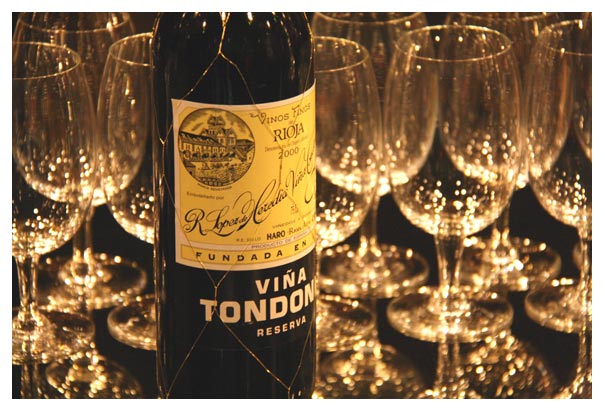Wine Pilgrims in Rioja
/Not since Raiders of the Lost Ark has a warehouse stretched as endlessly as the Marques de Riscal’s aging room, where 4 million bottles recede into the distance like a Renaissance diagram of one-point perspective. But this is no CGI effect. What’s more, it’s only half the winery’s 7.6-million bottle cache resting in storage.
Over at Lopez de Heredia, 7,000 square meters of underground aging tunnels burrow through the rock. You need a road map to navigate these hand-excavated corridors, lined with thousands of oak barrels and a black mold that’s thicker than forest moss. (“It helps control the temperature and humidity,” our guide claims.) Here Rioja ages for a decade or two before its release.
Nothing comes small in Rioja. Not the craggy Sierra Cantabria mountains that tower above miles of vines; nor the warehouse-sized wineries that line the road; nor the ambitions of estate owners who hire star architects like Frank Gehry or Santiago Calatrava to design shiny, futuristic wineries; nor the sheer numbers of bottles produced. A dozen wineries make 10 million bottles each, and the region totals 400 million bottles per year. The entire DOCG zone of Barolo, in contrast, produces 8 to 9 million. (Admittedly, Rioja’s production is only half that of Bordeaux, and a fraction of Gallo’s mind-boggling 1 billion bottles. But still, it’s big.) A thousand wineries exist in this region, which is big enough—80 miles long—to contain three distinct sub-zones (Alta, Alvesa, and Baja); 600 of those wineries produce classified Rioja.
We managed to visit six during our RIOJA ROUNDUP tour this week, plus four in Ribera del Duero. Like the backpacking pilgrims we see briskly walking along the Camino de Santiago, we’re on a mission, but ours is one of enological enlightenment, and our Holy Grail is tasting the full range of Riojan wine today.
And boy, what a range. On one extreme is Lopez de Heredia, Rioja’s third oldest winery. The last of the Mohicans, they make wine as if it’s still 1877, their founding year. Baskets made of poplar wood are used at harvest to better retain the grapes’ natural yeast; towering 120-year-old wood vats are still used for fermentation; temperature control is done by flinging open doors and windows during the chilly fall months; wooden canes tied in bundles are used to filter the free-run juice; skins are pressed in old-fashioned basket presses dating from 1911 and 1920; racking is done by gravity; and the 20-year-old Gran Reserva is bottled by hand directly from the barriques. The result is a quintessential old-style Rioja: aged until gently oxidized, coca-cola in color, silky in texture, and with a delicate, dried-flower bouquet. It’s surprisingly good.
In contrast, not one microbe of mold can be found anywhere in Ramirez de Ganuza’s spotless cellar. Here modern winemaking is an extreme sport. Owner Fernando Ramirez de Ganuza is obsessive in his quest for tools and techniques that can make wine cleaner, purer, better. To be sure, he has an appreciation forterroir. Before starting his winery in 1989, he made a business of buying small vineyard plots from farmers, joining them together into larger parcels, then selling them to the new wineries popping up like cetasmushrooms along the Ebro river. Pretty soon, he joined them himself and became part of the viticultural avant garde led by Roda, Sierra Cantabria, Artadi, and others who promoted the idea that wine growers and wine makers should work hand in glove (a novelty then).
Ganuza introduced some other novel ideas: He pays harvest workers by the hour, not the kilo. He puts sun-warmed grapes in a chilling chamber for 24 hours before fermentation—a response to global warming. (Grapes are ripening earlier, which means harvest now occurs in late summer, and that means grapes come in from the field all hot and bothered, and can potentially begin microfermentation even before reaching the winery vats. Not good.) Ramirez de Ganuza also cuts his grape bunches in half and vinifies the greener tips in a nouveau, carbonic macerated style called Erre Punto, while the more mature tops go into his Rioja Reserva. He also pounced on a UC Davis study that shows adding white skins to macerating reds can help fix the color and recently began following this technique. (The accidental byproduct is a new white wine from Viura and Malvasia grapes.)
In between these extremes, one finds every possible combination of priorities and techniques. Roda, for instance, cultivates 28 vineyard plots in the three regions of Rioja and blends the different parcels—an old strategy followed by a modernist winemaker. Contino, in contrast, was an early adapter of the chateauconcept, growing all their own grapes on the property right next to their house. Roda is doing extensive research on tempranillo clones, while Contino helped save the hard-to-ripen graciano grape from extinction. (Riojan joke: The name graciano comes from gracias, no! —farmers’ reaction to growing the fussy grape.)
Different grapes, different focuses, different strokes for different folks. Rioja is truly an enophile’s feast, with so many styles to sample. Our group’s favorites this week turned were:
• Two from Abadia Retuerta in Ribero del Duero: I loved their blend, Selección Especial 2006 (75/20/5 tempranillo/ cabernet/merlot), while others preferred their new 100 percent cabernet, Pago Valdebellon 2005
• Matarromero Crianza 2007, Bodega Matarromera: A good, classic Ribero del Duero, with dark fruit, earth, and leather. Yum.
• Verdejo 2009, Monteabellón: Of all the whites tasted, this Verdejo was a real stand-out, offering intense aromatics and a mouth-watering concentration of fruit.
• Erre Punto 2009, Remirez de Ganuza: While we all loved their Rioja Reserva, this young, carbonic maceration wine was so unique and so good we just couldn’t get enough.
• Graciano 2006, Contino: Blackberries and clove, with hints of white pepper and eucalyptus. Lots of distinctive personality, and always a winner.
• Rioja Gran Reserva 2000, Miguel Merino: An elegant, juicy, food-friendly classic from the smallest estate in Rioja, and one of our favorites.







